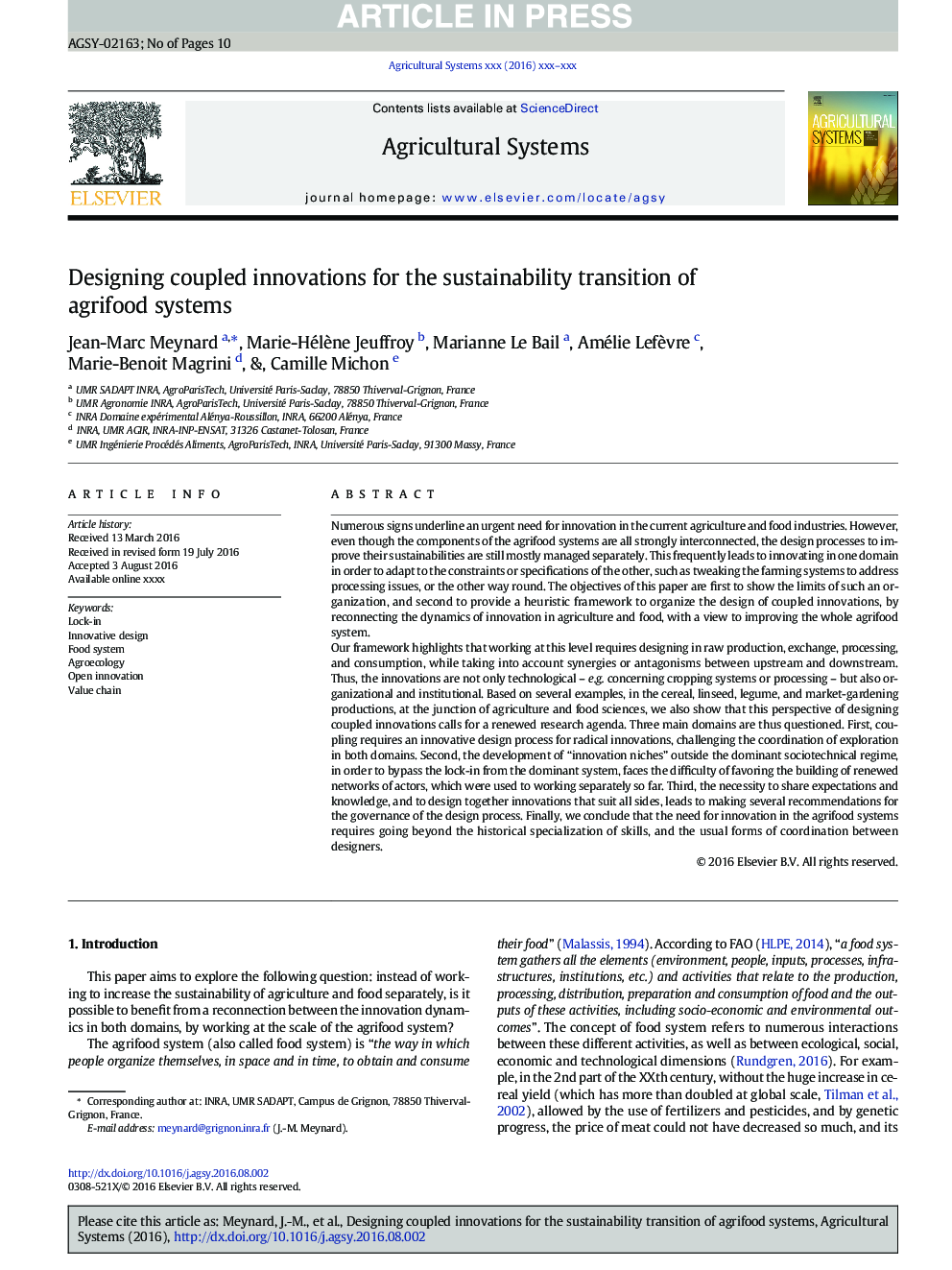| کد مقاله | کد نشریه | سال انتشار | مقاله انگلیسی | نسخه تمام متن |
|---|---|---|---|---|
| 5759612 | 1623213 | 2017 | 10 صفحه PDF | دانلود رایگان |
عنوان انگلیسی مقاله ISI
Designing coupled innovations for the sustainability transition of agrifood systems
ترجمه فارسی عنوان
طراحی نوآوری های همراه برای انتقال پایدار سیستم های کشاورزی
دانلود مقاله + سفارش ترجمه
دانلود مقاله ISI انگلیسی
رایگان برای ایرانیان
کلمات کلیدی
قفل در طراحی نوآورانه، سیستم غذا، کشاورزی نوآوری باز زنجیره ارزش،
ترجمه چکیده
چارچوب ما مشخص می کند که کار در این سطح نیاز به طراحی در تولید خام، مبادله، پردازش و مصرف دارد، در حالی که با توجه به همکاری و یا اختلاف بین جریان های بالادست و پایین دست. بنابراین، نوآوری ها نه تنها تکنولوژیک هستند - به عنوان مثال در مورد سیستم های برداشت یا پردازش - بلکه سازمانی و نهادی. بر اساس چندین مثال، در محصولات غلات، لاین، حبوبات و باغبانی، در کنار علم کشاورزی و مواد غذایی، ما همچنین نشان می دهیم که این دیدگاه طراحی نوآوری های مرتبط با یکدیگر، نیازمند یک برنامه تحقیق جدید است. در نتیجه سه حوزه اصلی مورد سوال قرار می گیرند. اول، اتصال نیاز به یک فرایند طراحی نوآورانه برای نوآوری های رادیکال، به چالش کشیدن هماهنگی اکتشاف در هر دو حوزه است. دوم، توسعه نوآوری نوآوری؟ خارج از رژیم حاکم بر جامعه شناسی، به منظور دور زدن قفل از سیستم غالب، با مشکل ایجاد تخریب شبکه های بازیگران مواجه می شود که به طور جداگانه کار می کنند. سوم، ضرورت به اشتراک گذاشتن انتظارات و دانش و طراحی نوآوری هایی که به همه ی آنها احتیاج دارد، منجر به ایجاد توصیه های متعدد برای مدیریت فرآیند طراحی می شود. در نهایت، ما نتیجه می گیریم که نیاز به نوآوری در سیستم های کشاورزی نیاز به فراتر رفتن از تخصص تخصصی تاریخی و فرم های معمول هماهنگی بین طراحان دارد.
موضوعات مرتبط
علوم زیستی و بیوفناوری
علوم کشاورزی و بیولوژیک
علوم کشاورزی و بیولوژیک (عمومی)
چکیده انگلیسی
Our framework highlights that working at this level requires designing in raw production, exchange, processing, and consumption, while taking into account synergies or antagonisms between upstream and downstream. Thus, the innovations are not only technological - e.g. concerning cropping systems or processing - but also organizational and institutional. Based on several examples, in the cereal, linseed, legume, and market-gardening productions, at the junction of agriculture and food sciences, we also show that this perspective of designing coupled innovations calls for a renewed research agenda. Three main domains are thus questioned. First, coupling requires an innovative design process for radical innovations, challenging the coordination of exploration in both domains. Second, the development of “innovation niches” outside the dominant sociotechnical regime, in order to bypass the lock-in from the dominant system, faces the difficulty of favoring the building of renewed networks of actors, which were used to working separately so far. Third, the necessity to share expectations and knowledge, and to design together innovations that suit all sides, leads to making several recommendations for the governance of the design process. Finally, we conclude that the need for innovation in the agrifood systems requires going beyond the historical specialization of skills, and the usual forms of coordination between designers.
ناشر
Database: Elsevier - ScienceDirect (ساینس دایرکت)
Journal: Agricultural Systems - Volume 157, October 2017, Pages 330-339
Journal: Agricultural Systems - Volume 157, October 2017, Pages 330-339
نویسندگان
Jean-Marc Meynard, Marie-Hélène Jeuffroy, Marianne Le Bail, Amélie Lefèvre, Marie-Benoit Magrini, Camille Michon,
